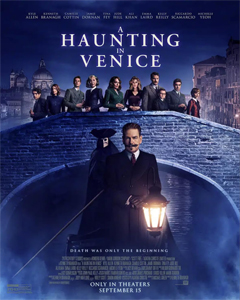After adapting two Agatha Christie classics – “Murder on the Orient Express” and “Death on the Nile” – with an edgier, darker version of Poirot, writer Michael Green and director/star Kenneth Branagh go all-original with “A Haunting in Venice.”
Poirot by way of Branagh
Branagh makes it clearer than ever that he’s not interested in faithfully translating Poirot from the page. Rather, he wants to do his own thing.
This leads to a question: Since Branagh’s Poirot, who is hiding out from clients in the waterlogged Italian city because he doesn’t want to solve crimes anymore (!), is so unlike Christie’s Poirot, why call him Poirot? Two answers come to mind. One, this is a continuation of the character established in the first two films, so we already know him. And two, more people will see the film if it’s part of an IP.
“A Haunting in Venice” (2023)
Director: Kenneth Branagh
Writers: Michael Green
Stars: Kenneth Branagh, Michelle Yeoh, Jamie Dornan
The downside of the latter point is a lot of Christie fans will dislike this film because Branagh’s character continues to not be Poirot; plus, this time it’s not even based on a Christie plot.
Green borrows a couple items from “Hallowe’en Party”: a children’s fete with bobbing-for-apples, and the presence of Ariadne Oliver (Tina Fey). In the latter case, she is of course AINO (Ariadne In Name Only). Green takes Poirot’s loner tendencies so far that he “doesn’t have friends” (by his own admission) in this continuity.
Ariadne, the successful mystery author, is the sleuth’s good friend in the books, but here she is merely an acquaintance. Early on, Fey’s perpetual smirk does suggest some of the novels’ bantering quality between the friends. But “Venice” resists such coziness, especially when Poirot insists that everyone – even Ariadne – is a suspect.
‘Hallowe’en Party’ … but only for starters
“Hallowe’en Party” is set in a rather nondescript (Christie wasn’t big on building descriptions) library in an English town. The film moves the action to Venice, and Branagh justifies this move in almost every frame. The party takes place at a gorgeously decrepit building at a canal’s edge. When a storm rolls in, all the suspects are trapped there – thus allowing for the same contained setting of the first two films.
Cinematographer Haris Zambarloukos lusciously showcases this uniquely ancient city with canals instead of streets (not that this film will displace Seventies classics like “Don’t Look Now”). Composer Hildur Guðnadóttir and the sound design team further set the mood. “Venice” is shamelessly soaked in a vibe as it builds off a standard conflict of this subgenre.

Poirot believes mediums engage in sheer trickery, putting him at odds with Joyce Reynolds (Michelle Yeoh), who practices the art. She’s been called in for a séance by house matriarch Rowena Drake (Kelly Rielly), whose daughter committed suicide a year prior.
The cast of characters is well-drawn. Particularly interesting is bookish young Leopold Ferrier (Jude Hill), who takes care of his father, Leslie (Jamie Dornan), a doctor who has PTSD from World War II. (The action is set in 1947, moved back from “Hallowe’en Party’s” 1969.)
Again, it’s about the style
As with the previous two films, Green is interested in commenting on midcentury Europe, as he also features two mediums’ assistants who are simply looking for a better life. The writer isn’t above having Poirot be a PC moral sounding board, noting that one of the travails of being “the help” is being called “the help.”
The novels’ Poirot – like Christie – lived in a time when domestic help was a respected job, so such a view would be out of place. The Branagh Poirots have always been historic-by-way-of-the-21st-century.
So you won’t get totally swept back to the midcentury, but you will get swept up the canals of Venice straight to this fascinating abode. Neither the place nor the narrative will haunt you to your core, but the story and character motivations are solid, and the revelation is satisfying.
The film is an odd duck, as it brazenly departs from Christie canon in so many ways (the notion that there are copies of “Hallowe’en Party” with “Haunting in Venice” covers is laughable) that you could label Green and Branagh “daring.”
Yet it’s also a safe-for-the-whole-family horror movie. Among forgiving Christie fans and horror fans, “A Haunting in Venice” will go down as a stylish curiosity.

